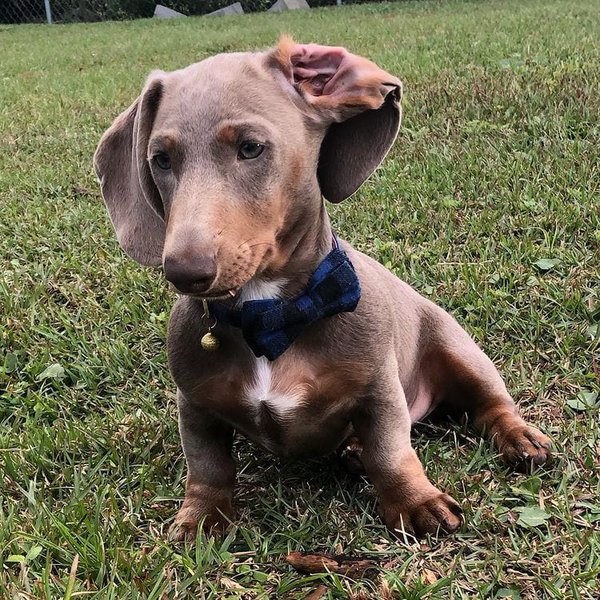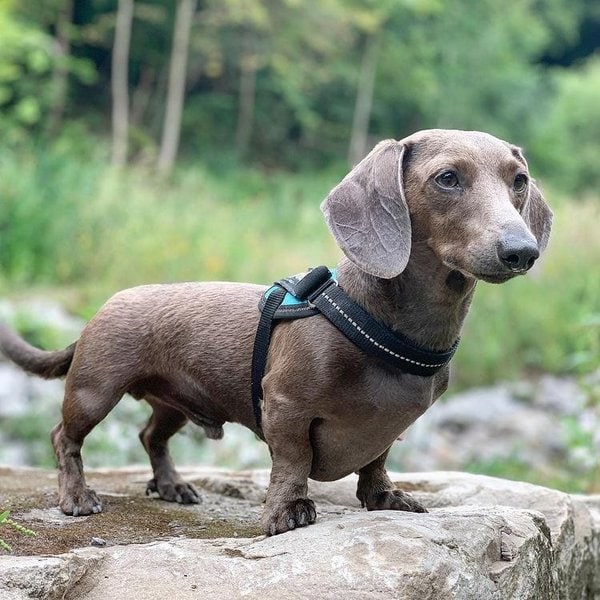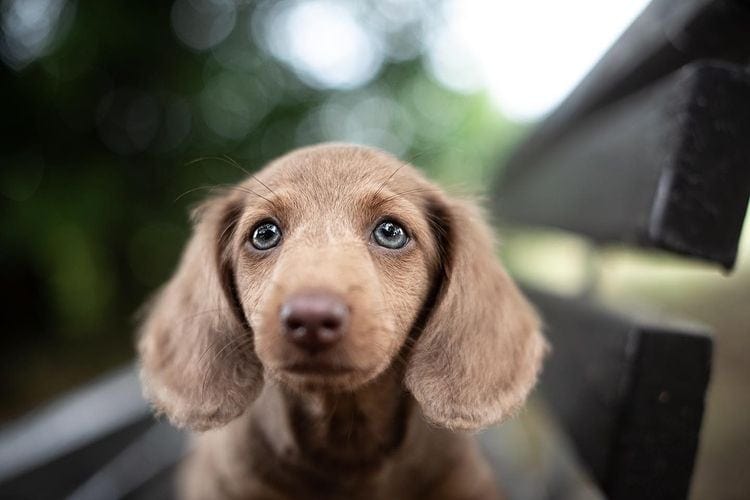Isabella Dachshunds have a fawn coat color over their entire body but may also have a cream or tan pattern with the fawn. The fawn color results from a recessive gene carried by both parents which causes dilution to the chocolate color. This gene can also cause skin problems. But the Isabella Dachshund is generally a healthy and loyal family dog.
Unlike other dog breeds, the AKC gives plenty of concessions to the Dachshunds when it comes to the coat color and types.
In this article, we tell you everything you need to know about the Isabella Dachshund including its unique coat color and a lot of other details that make this Dachshund variant unique. Keep reading!
What Is An Isabella Dachshund? Is It The Same As A Fawn Dachshund?

Isabella in the Dachshund breed is an alternative name for the fawn coat coloration. This is why it is sometimes called Fawn Dachshund.
The fawn color is caused by a recessive gene carried by both parents. What the recessive gene does is cause a color dilution to the base chocolate color.
The Isabella color can appear in all three coat types of the Dachshund: the smooth, the wirehaired, and the longhaired. It is also exhibited in both the standard size Dachshund (16-32 pounds) and the miniature size (11 pounds and below).
Isabella Dachshunds can have 3 coat color variations:
- The solid-colored Isabella has the fawn or washed-out chocolate color all over the body. It has no tan or cream points because the gene for these colors is absent.
- The Isabella/cream (fawn/cream) coat has diluted cream and chocolate colors because of the recessive gene carried by the parents.
- The Isabella/tan (fawn/tan) coat has washed out chocolate and tan colors, again owing to the recessive genes in the puppy’s parents.
In all three Isabella variations, the eyes, nose, and nails are gray. In the Isabella/cream and the Isabella/tan variations, the cream or tan markings will appear over the eyes, under the lip, on the sides of the jaw, on the breast, on the inner side of the ear, behind and inside the front legs, on the paws, around the anus, and sometimes on the throat.
A third or half of the tail is also tan or cream. The AKC considers excessive tan or cream patterns to be undesirable.
How Does An Isabella Dachshund Differ From Blue Dachshunds? What About Cream Dachshunds?

As shown in the previous section, an Isabella Dachshund has a washed-out chocolate color throughout the body and can have tan or cream patterns as variations. Its eyes, nose, and nails are gray.
The Isabella is similar to the blue and cream Dachshunds in that their coat colors result from a recessive gene for color dilution which is carried by both parents.
The Blue Dachshund has a washed-out black color that resembles a dark greyish blue color. It can appear more of a lavender-gray or metal-gray tone. The nails, eyes, and ears are usually gray, but some may take a black color, which is within the breed standard.
The difference between the blue and the isabella dachshunds is the base color of their coat, that is chocolate or black. The biological dilution of their coat color gives rise to their unique hues.
The Cream Dachshund seems to have more descriptions for its coat color as well as a bit of confusion. You’ll hear of English and American creams, and the dilute or solid cream.
The English creams are attributed to the chinchilla gene that dilutes the red and tan color to cream. According to some, the American cream results from the blue dilute gene and tends to turn darker with age, unlike the English cream that turns lighter with age.
In the English context, the solid cream Dachshund is associated with a cream coat lineage resulting from the dilution of the red color. The entire body is cream with dark brown eyes, and a black nose and nails.
The dilute cream is associated with the American cream and considered by some extreme light red. The red-greenish eyes and liver nails are often used to qualify it a light red.
Isabella Dachshunds Skin Problems
Despite its appealing color, the gene that causes color dilution in the Isabella can also cause skin issues. The most common is Color Dilution Alopecia (CDA), also known as Color Mutant Alopecia.
Symptoms Of CDA
Hair Loss And Eventual Baldness
The color dilution gene causes the hair shaft to thin and weaken and the hairs break or fall off the follicle. This usually starts in the late puppyhood or young adulthood and will cause the dog to become completely bald over time.
Weakened Skin
CDA also causes your dog’s skin to thin, and this makes it weak and susceptible to extreme dryness, secondary infections, sunburn, folliculitis, overall skin sensitivity, and skin cancer.
CDA Treatment
There is no treatment for CDA. As such, medical interventions are aimed at controlling the effects of secondary infections and offering relief from skin discomfort. Nonetheless, diet supplementation with Melatonin or Retinoids can be used to stimulate hair growth.
Products like the Davis TheraCoat for Pets are used to help heal the skin and promote hair regeneration. The effects of this product are noticed within 30 days of use.
Avoid using tough brushes and harsh grooming products as these will worsen skin conditions, causing more hair breakage and skin irritation. Shampoos with salicylic acid and sulfur can help reduce the plugging of the follicles.
Also, dressing your dog with a sun-shield like the Gold Paw Sun Shield Dog Tee will protect them from the UV rays and the effects of sunburn.
Remember to always work with your dog’s vet when dealing with health conditions.
Other Common Health Problems Of An Isabella Dachshund
Regardless of skin conditions, Isabella Dachshunds are generally healthy and can live for 12-16 years with proper care, diet, and exercise. Exercise will maintain the muscle tone of the breed’s long body.
But Dachshunds can also be prone to other health problems:
Patellar Luxation
Patellar luxation is a common condition among Dachshunds and other small and miniature breeds. The condition occurs when the kneecap cartilage is damaged, causing it to dislocate and move out of its usual position.
Patellar luxation is mostly a congenital defect and can be passed on through genes. Obesity and trauma to the knee are also possible causes.
Since it is usually bilateral (on both legs), using a pair of leg braces like the NeoAlly Short Dog Leg Brace is advised. Seek the intervention of your dog’s vet soon as you notice the symptoms. Untreated Patella causes acute pain and can lead to permanent lameness.
Hyperadrenocorticism (Cushing’s Disease)
Cushing’s disease occurs with the malfunction of the adrenal glands causing overproduction of the steroid hormone. Dachshunds are prone to this condition and research indicates that it can be passed through lineage.
Back Disc Damage
You should be extremely careful about preventing disc damage in your dog’s long back. Do this by avoiding overfeeding and obesity, as well as any activity that could lead to a back injury.
This is known as the intervertebral disk disease (IVDD) which is more common in Dachshunds due to their elongated body.
Ear Infections
The Dachshund’s drop ears can create the environment for infections and make it go unnoticed. Ensure that your dog’s ears are always clean.
Other rare health conditions that may affect your Isabella Dachshund include eye infections, hyperthyroidism, and heart problems.
Temperament Of An Isabella Dachshund
Dachshunds are described as friendly, lively, curious, and extremely courageous such that they can even be rash.
Their bravery is often traced to their original hunting role which involved pulling prey out of their underground hideouts, thanks to Dachshund’s short stature.
Dachshunds carry their head in a bold and confident posture. This explains why a Dachshund that portrays a sense of shyness is considered by the AKC’s as a fault. Instead, Dachshunds are intelligent and always portray an alert facial expression.
Since they are naturally pack dogs, Dachshunds are loyal family dogs and will do well with children and fellow Dachshunds. Their attachment to family makes them prone to separation anxiety if left alone for long hours.
Away from these positive traits, Dachshunds can also show the following temperament minuses.
- They can bark excessively especially at strangers and dogs from other breeds. This, however, makes them good watchdogs.
- They can be stubborn, some will even say bossy and manipulative.
- Their hunting instinct can cause them to chase every little creature that appears on their way and also escape by breaking house or digging holes.
Some will attribute temperament differences among Dachshunds to coat type, with the smooth coat associated with being bossy, the wirehaired considered to be extrovert, and fun-loving and the longhaired Dachshund said to be the easy-going type.
Like all other dogs, Dachshunds will require early socialization and training. Even though they are quick to learn, you may need extra patience for their stubbornness and the tendency to ignore commands.

Related Questions
How Much Does An Isabella Dachshund Cost? Dachshund prices can be as diverse as their coat colors with those considered rare costing more. You can pay a price ranging between $400 and $3,500 for an Isabella Dachshund depending on the breeder. The average price ranges around $1,500. Dachshunds with limited papers also cost less than those with full papers.
Are Isabella Dachshunds Rare? Yes! Isabella Dachshunds are rare for two reasons. Their coat coloration results from a recessive gene that is not reproduced as much as the black, red, chocolate, tan, and cream bi-colors. It is also rare because some breeders are cautious about reproducing the skin conditions associated with the Isabella Dachshund.
What Is The Rarest Dachshund Color? The solid black coat is considered the rarest among other Dachshund color coats. The shiny solid black color in the Dachshund is due to the presence of the ‘B’ gene and the absence of the gene for tan or cream patterns. The eyes, nose, and nails are also black.





